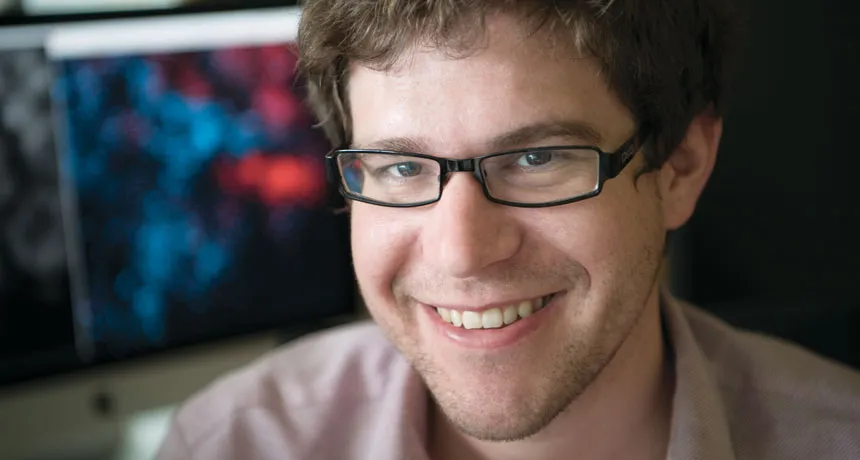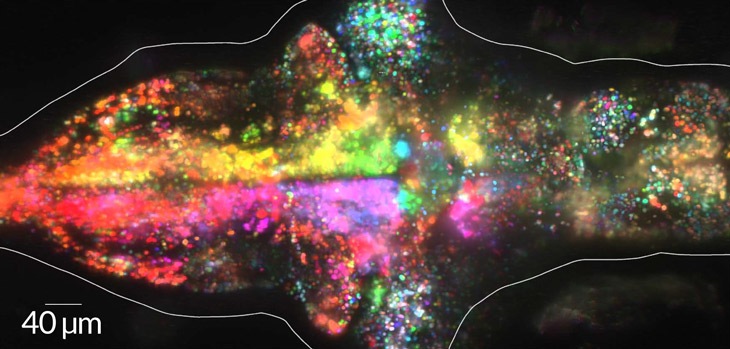Jeremy Freeman seeks to simplify complex brain science
New tools distill mountains of data to help scientists understand the brain

“Jeremy is an extreme simplifier,” says collaborating neuroscientist Corey Ziemba.
James Kegley/HHMI
Jeremy Freeman, 30
Neuroscientist
Howard Hughes Medical Institute, Janelia Research Campus
Jeremy Freeman loves clean, simple lines. To see his bent toward aesthetic minimalism, you need look no further than his spare, calm website that slowly shifts colors.
In the past, this fixation with style has occasionally veered toward the extreme. In graduate school at New York University, “he decided that capital letters were ugly,” says collaborator Corey Ziemba, a neuroscientist at NYU. “He would create a Freeman brand of everything in lower case.” Not even ruthless mocking could dissuade him, Ziemba says.
But this steely aesthetic sense is about more than just good looks. It signifies a precision and clarity in Freeman’s thinking, his colleagues say. “We talk about complexifiers and simplifiers,” Ziemba says. “Jeremy is an extreme simplifier.”
Now just 30, Freeman’s influential papers provide clues to how people spot objects in a crowd, methods to build giant maps of the brain’s nerve cells and elegant insights into how nerve cells let us see and touch. As a group leader at Howard Hughes Medical Institute’s Janelia Research Campus in Ashburn, Va., Freeman is known for developing computer programs that allow him and colleagues to analyze and visualize data. He has turned his simplifying eye toward two deep, tangled and very ambitious challenges: He wants to understand how the brain works. And he wants to improve the way science is done along the way.
One of Freeman’s big projects is working with collaborators to study how nerve cells in the brains of mice respond to touch. As a powerful microscope peers into its brain, a mouse runs on a ball. Moveable walls surrounding the mouse form the corridors of a virtual maze, which the mouse feels with its whiskers. The whiskers send feedback to the brain, where genetically engineered nerve cells glow fluorescently as scientists watch with a specially designed microscope. Developed by Janelia colleague Nicholas Sofroniew, the method produces huge datasets that show when and where nerve cells are active.
Freeman’s role in this and other hands-on experiments has been to build better ways to make sense of the mountains of data. With a computer program called Thunder, developed by Freeman and colleagues, data once crunched overnight can now be whipped into shape in a few minutes.

That speed isn’t just convenient. With this nearly instant feedback, an experiment can be changed iteratively, guided by the results of the previous test, Freeman says. The process “allows new types of experiments,” ones that are more powerful than earlier attempts, Sofroniew adds. Already, with the help of Thunder, the team has pulled from the mess of data interesting clues to the patterns the brain uses to organize incoming touch information. Mice track the position of walls, for instance, by relying on many distinct clusters of nerve cells, groups called barrels.
This approach — get results, tweak the experiment, get new results and so on — seems obvious, but it wasn’t something that people regularly did, Freeman says. Brains, even of relatively simple organisms like fruit flies, are teeming with a huge variety of nerve cells that can behave differently depending on their connections, task and even time of day. Neuroscience data can quickly become difficult to manage. “Unless you’re thinking these things through carefully, and using good tools, things become really hard and inefficient,” he says.
While clean lines may describe Freeman’s thinking, his career is best described by lines that connect, often in surprising and interesting ways. On any given day, he’s equally likely to be analyzing enormous datasets of firing nerve cells, developing a software program to help visualize data or organizing coding events for the neuroscience community. CodeNeuro, which he co-leads, brings neuroscientists, data scientists, coders and experts in visualization together for special events, in San Francisco and New York City so far.
“I was always interested in the boundaries of disciplines,” Freeman says. As an undergraduate at Swarthmore College in Pennsylvania, he talked his way into a major that included math, biology and psychology by persuading the powers that be to call it neuroscience, a major that didn’t exist there at the time. “I get restless trying to work in one bubble, one conceptual space. I like to bring in new ideas from new domains, and I push myself to do that.”
Over the last few years, Freeman and colleagues have been cutting through the clutter and making new connections by designing software that makes data sharing easier. One of their programs, called Binder, lets researchers (or journalists, government officials or anyone else with an interesting dataset) easily share their results, but just as important, also the way they analyzed their dataset.
Binder is meant to fight against the unnecessary complexity that prevents people from sharing, Freeman says. “A lot of the systems in science now are from the past,” he says. “They’re built on very slow ways of sharing information, through journal articles. We need to move it forward. We need to make sharing really easy and efficient.” That kind of open communication is the way to make swift progress on the big questions that face neuroscientists today, he believes.
Scientists have used Binder during lab meetings to let everyone dig in to the problem at hand. Janelia scientists have used it to supplement published results with a reproducible version of the analyses. “Jeremy develops software tools that make other people’s science better,” says Karel Svoboda, a Janelia neuroscientist.
Binder’s appeal extends even farther afield. Scientists turned to the program to release data from the LIGO experiment, which made headlines earlier this year by discovering gravitational waves. Even journalists at BuzzFeed used it to invite others to see and explore their analyses of U.S. refugee data. Binder, or something like it, “will eventually revolutionize scientific publishing,” Svoboda says.
The desire to make analyses faster and sharing easier didn’t come from an expert coder who realized he could make a difference. It came from a person who saw clunky inefficiencies and wanted to fix them so badly that he decided to learn to code. “I forced myself to learn the ropes,” Freeman says. “I deliberately put myself into really challenging situations. I get in way over my head and I figure out how to crawl out.”
Freeman’s tendency to move from one project to another means he doesn’t know where he’ll be in 10 years, or what he’ll be working on — an uncertainty that has dogged him for a while now. His thoughts can often move past the task at hand, and he admits that colleagues often wonder, “Are you really doing the thing you say you’re doing…?” Although his wide-ranging interests may carry him to unexpected areas, one thing is certain: Once he gets there, his unconventional mind will find — or design — a way forward.







